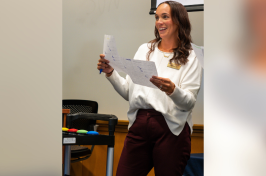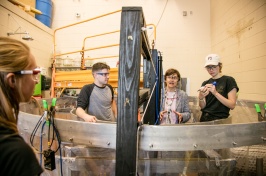UNH Scientists to Conduct NASA Amazon Forest Project

The megadrought in the Amazon rainforest during the summer of 2005 caused widespread damage and die-off to trees, as depicted in this photo taken in Western Amazonia in Brazil. Image credit NASA/JPL-Caltech.
DURHAM, NH -- NASA's Interdisciplinary Research in Earth Science program has funded scientists from the University of New Hampshire to conduct a comprehensive assessment of Amazonian forest resilience and vulnerability to drought in the wake of two Amazon megadroughts in 2005 and 2010.
The three-year, $1.8 million project is led by environmental scientist Michael Palace of UNH's Institute for the Study of Earth, Oceans, and Space (EOS) and leverages the expertise of six current and former scientists from the EOS Earth Systems Research Center. Approximately $1.1 million of the grant will go to UNH.
The interdisciplinary project will take a novel approach by integrating multi-sensor remote sensing from satellites and aircraft platforms, contemporary physiological measurements that can determine how much a forest "drinks," and analysis of an extensive paleoecological dataset, including pollen records dating back thousands of years that can identify periods of severe drought.
Tropical forests are critical drivers and components of atmospheric and terrestrial energy, carbon, water, and nutrient dynamics on a global scale, and large-scale changes have cascading effects. Most climate scenarios predict that tropical forests will experience reduced precipitation in addition to rising temperatures, and the response to these projected increases in drought frequency and intensity remains highly uncertain on both recent and historical timescales.
"Amazonia, at 5.5 million square kilometers, is the largest continuous tropical forest in the world and there is still no consensus on the overall forest response to the recent 2005 and 2010 Amazon megadroughts," says Palace.
Among other things, scientists are still debating whether or not the recently observed increases in extreme drought frequency are signs of an approaching "tipping point" at which the tropical forests undergo a sudden state shift, or dieback, and eventually convert to savanna.
"Anticipating the consequences of projected changes in precipitation patterns in tropical forests requires that additional information, such as our field and paleoecological data, be compared alongside remotely sensed data," Palace says, "and our interdisciplinary, integrated approach will provide a comprehensive assessment of drought response and predictive capability of forest response under future climate scenarios."
In addition to variability in climate projections, another source of uncertainty stems from a lack of understanding the physiological responses of the forest to water stress. To that end, EOS scientist Heidi Asbjornsenwill gather tree cores and conduct isotope analysis to determine the "water use efficiency" of trees—a measure of a plant's ability to simultaneously take in atmospheric carbon dioxide through tiny leaf pores without losing too much water during the process of photosynthesis. This will provide for better interpretation of both remotely sensed data and pollen time-series analysis.
Notes Palace, "What we'll see through our contemporary satellite analysis and on-the-ground field studies is where the forest, and what species in particular, is vulnerable or resilient. Some areas will not be impacted by drought while others might be more susceptible." He adds, "The research and analysis will aid future scientific efforts and policy planning for conservation organizations and government agencies."
Other institutions participating in the project include the Florida Institute of Technology; Applied Geosolutions, LLC of Durham; NASA Goddard Space Flight Center; the University of California, Santa Barbara; U.S. Forest Service; Federal University of Goais; and the Brazilian Space Agency.
NASA's Interdisciplinary Research in Earth Science program supports research that offers a fundamental advance to our understanding of the Earth system, is based on remote sensing data, especially satellite observations, but includes suborbital sensors as appropriate.
The University of New Hampshire, founded in 1866, is a world-class public research university with the feel of a New England liberal arts college. A land, sea, and space-grant university, UNH is the state's flagship public institution, enrolling 12,300 undergraduate and 2,200 graduate students.
Image to download: http://www.eos.unh.edu/newsimage/Amazon_drought_lg.jpg
Caption: The megadrought in the Amazon rainforest during the summer of 2005 caused widespread damage and die-off to trees, as depicted in this photo taken in Western Amazonia in Brazil. Image credit NASA/JPL-Caltech.
-30-
Latest News
-
October 30, 2024
-
October 10, 2024
-
October 8, 2024
-
October 3, 2024
-
October 1, 2024
















































